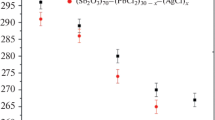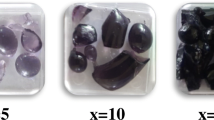New chloroantimonite glasses were obtained in the Sb2O3 – PbCl2 –AgCl ternary system. Their thermal, optical, and mechanical properties are studied. The concentration of silver chloride increases at the expense of antimony oxide accordingtothe following composition rules: (80–x)Sb2O3 –20PbCl2 –xAgCl and (70–x)Sb2O3 –30PbCl2 –xAgCl. Depending on the AgCl content, Vickers microhardness varied between 110 MPa and 140 MPa. The elastic moduli were measured by ultrasonic velocity. The optical transmission range extended from 400 nm in the visible spectrum to 7 μm in the infrared spectrum. The refractive index was close to 2. The glass transition temperature measured by the DSC ranged from 250 to 290°C. It is shown that the glass transition temperature decreases as AgCl substitutes for Sb2O3 and a more stable system was with 20% PbCl2 in the (80–x)Sb2O3 –20PbCl2 –xAgCl.









Similar content being viewed by others
References
W. H. Zachariasen, “The atomic arrangement in glass,” J. Chem. Soc., 54, 3841–3851 (1932).
A. Winter, “Glass formation,” J. Am. Ceram. Soc., 40, 54–58 (1957).
A. Winter, “Transformation region of glass,” J. Am. Ceram. Soc., 26, 189–200 (1943).
J. F. Bednarik and J. A. Neely, “A single component antimony oxide glass and some of its properties,” Glass Tech. Ber., 55, 126–129 (1982).
B. Dubois, H. Aomi, J. J. Videau, and J. Portier, “New oxyhalide glasses involving Sb2O3,” Haggenmuller, Mater. Res. Bull., 19, 1317–1323 (1984).
M. R. Sahar, M. M. Ahmed, and D. Holland, “The crystallization of Sb2O3–PbCl2 –ZnCl2 glasses,” Phys. Chem. Glasses, 31, 126–131 (1990).
M. R. Sahar and D. Holland, “Chemical durability of oxychloride glasses,” J. Non-Cryst. Solids, 140, 107–111 (1992).
L. Zan, J. S. Zhong, and Q. R. Luo, “New oxysulphide glasses from the Sb2O3–Sb2S3MxS system,” J. Non-Cryst. Solids, 256–257, 396–399 (1999).
A. Datta, A. K. Giri, and D. Chakravorty, “Ac conduction in sol-gel derived glasses in the SiO2 –As2O3 system,” Physic. Rev., B 47, 16242–16246 (1993).
B.V. R. Chowdari and S. K. Akhter, “Studied of lithium phosphoantimonite glass system,” Solid State Ionics, 25, 109–119 (1987).
S. K. Akhter, “Physical characterization of lithium phosphoantimonite glass system,” Solid State Ionics, 51, 305–310 (1992).
J. S. Wang, E. E. Vogel, and E. Snitzer, “Tellurite glass: a new candidate for fiber devices,” Opt. Mater., 3, 187–203 (1994).
R. E. De Araujo, C. B. De Araujo, G. Poirier, M. Poulain, and Y. Messaddeq, “Nonlinear optical bisoption of antimony and lead oxyhalide glasses,” Appl. Phys. Lett., 81, 4694–4696 (2002).
G. Poirier, M. A. Poulain, and M. J. Poulain, “Effects of carbon, hydrocarbon and hydroxide impurities on praseodymium doped arsenic sulfide based glass,” J. Non-Cryst. Solids, 284, 117–122 (2001).
M. T. Soltani, A. Boutarfaia, R. Makhloufi, and M. Poulain, “New alkali antimonite glass,” J. Phys. Chem. Solids, 64, 2307–2312 (2003).
M. Legouera, P. Kostka, and M. Poulain, “Glass formation in the Sb2O3–ZnBr2 binary system,” J. Phys. Chem. Solids, 65, 901–906 (2004).
M. T. Soltani, T. Djouama, A. Boutarfaia, M. Poulain, and J. Optoelectron, “New heavy metal oxide glasses based on Sb2O3,” Advanced Mater. Symposia, 1, 339–342 (2009).
M. Iezid, M. Legouera, F. Goumeindane, M. Poulain, V. Nazabal, and R. Lebullenger, “Glass formation in the Sb2O3–CdCl2 –SrCl2 binary system,” J. Non-Cryst Solids, 357, 2984–2988 (2011).
J. M. Stevels, Progress in the Theory of the Physical Properties of Glasses, Elsevier, New York (1948).
M. Petzold, J. Landgraf, M. Füting, and J. M. Olaf, “Application of atomic force microscopy for microindentation testing,” Thin Sol. Films, 264, 153–158 (1995).
Author information
Authors and Affiliations
Corresponding author
Additional information
Published in Fizyko-Khimichna Mekhanika Materialiv, Vol. 52, No. 1, pp. 36–43, January–February, 2016.
Rights and permissions
About this article
Cite this article
Yezli, D., Legouera, M., El Abdi, R. et al. Mechanical, Thermal, and Optical Properties of New Chloroantimonite Glasses in the Sb2O3–PbCl2 –Ag Cl System. Mater Sci 52, 33–41 (2016). https://doi.org/10.1007/s11003-016-9923-3
Received:
Published:
Issue Date:
DOI: https://doi.org/10.1007/s11003-016-9923-3




